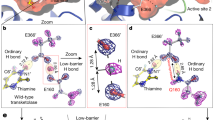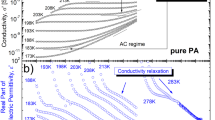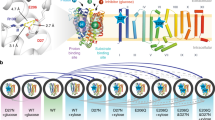Abstract
The covalent chemistry of reactants tethered within a single protein pore can be monitored by observing the time-dependence of ionic current flow through the pore, which responds to bond making and breaking in individual reactant molecules. Here we use this ‘nanoreactor’ approach to examine the reaction of a quinone with a thiol to form a substituted hydroquinone by reductive 1,4-Michael addition. Remarkably, a primary hydrogen–deuterium isotope effect is readily detected at the single-molecule level during prototropic rearrangement of an initial adduct. The observation of individual reaction intermediates allows the measurement of an isotope effect whether or not the step involved is rate limiting, which would not be the case in an ensemble measurement.
This is a preview of subscription content, access via your institution
Access options
Subscribe to this journal
Receive 12 print issues and online access
$259.00 per year
only $21.58 per issue
Buy this article
- Purchase on Springer Link
- Instant access to full article PDF
Prices may be subject to local taxes which are calculated during checkout





Similar content being viewed by others
References
Moffitt, J. R., Chemla, Y. R., Smith, S. B. & Bustamante, C. Recent advances in optical tweezers. Annu. Rev. Biochem. 77, 205–228 (2008).
Bustamante, C. In singulo biochemistry: when less is more. Ann. Rev. Biochem. 77, 45–50 (2008).
Benkovic, S. J., Hammes, G. G. & Hammes-Schiffer, S. Free-energy landscape of enzyme catalysis. Biochemistry 47, 3317–3321 (2008).
Liang, J. & Fernandez, J. M. Mechanochemistry: One bond at a time. ACS Nano 3, 1628–1645 (2009).
Puchner, E. M., Franzen, G., Gautel, M. & Gaub, H. E. Comparing proteins by their unfolding pattern. Biophys. J. 95, 426–434 (2008).
Zhuang, X. Single-molecule RNA science. Annu. Rev. Biophys. Biomol. 34, 399–414 (2005).
Comellas-Aragones, M. et al. A virus-based single-enzyme nanoreactor. Nature Nanotechnol. 2, 635–639 (2007).
Liu, S., Abbondanzieri, E. A., Rausch, J. W., Le Grice, S. F. & Zhuang, X. Slide into action: dynamic shuttling of HIV reverse transcriptase on nucleic acid substrates. Science 322, 1092–1097 (2008).
Yanagida, T., Iwaki, M. & Ishii, Y. Single molecule measurements and molecular motors. Phil. Trans. R. Soc. B 363, 2123–2134 (2008).
Park, H., Toprak, E. & Selvin, P. R. Single-molecule fluorescence to study molecular motors. Q. Rev. Biophys. 40, 87–111 (2007).
Brandenburg, B. & Zhuang, X. Virus trafficking - learning from single-virus tracking. Nat. Rev. Microbiol. 5, 197–208 (2007).
Xie, X. S., Choi, P. J., Li, G. W., Lee, N. K. & Lia, G. Single-molecule approach to molecular biology in living bacterial cells. Ann. Rev. Biophys. 37, 417–444 (2008).
Ho, W. Single-molecule chemistry. J. Chem. Phys. 117, 11033–11061 (2002).
Rao, B. V., Kwon, K. Y., Liu, A. & Bartels, L. Measurement of a linear free energy relationship one molecule at a time. Proc. Natl Acad. Sci. USA 101, 17920–17923 (2004).
Maksymovych, P., Sorescu, D. C., Jordan, K. D. & Yates, J. T., Jr. Collective reactivity of molecular chains self-assembled on a surface. Science 322, 1664–1667 (2008).
Grandbois, M., Beyer, M., Rief, M., Clausen-Schaumann, H. & Gaub, H. E. How strong is a covalent bond? Science 283, 1727–1730 (1999).
Garcia-Manyes, S., Liang, J., Szoszkiewicz, R., Kuo, T. L. & Fernández, J. M. Force-activated reactivity switch in a bimolecular chemical reaction. Nature Chem. 1, 236–242 (2009).
Roeffaers, M. B. et al. Spatially resolved observation of crystal face dependent catalysis by single turnover counting. Nature 439, 572–575 (2006).
Xu, W., Kong, J. S., Yeh, Y. T. & Chen, P. Single-molecule nanocatalysis reveals heterogeneous reaction pathways and catalytic dynamics. Nature Mater. 7, 992–996 (2008).
Bayley, H., Luchian, T., Shin, S. H. & Steffensen, M. B. in Single Molecules and Nanotechnology (eds. Rigler, R. & Vogel, H.) 251–277 (Springer, 2008).
Shin, S. H., Luchian, T., Cheley, S., Braha, O. & Bayley, H. Kinetics of a reversible covalent-bond forming reaction observed at the single molecule level. Angew. Chem. Int. Ed. 41, 3707–3709 (2002).
Luchian, T., Shin, S. H. & Bayley, H. Kinetics of a three-step reaction observed at the single molecule level. Angew. Chem. Int. Ed. 42, 1926–1929 (2003).
Luchian, T., Shin, S. H. & Bayley, H. Single-molecule covalent chemistry with spatially separated reactants. Angew. Chem. Int. Ed. 42, 3766–3771 (2003).
Shin, S. H. & Bayley, H. Stepwise growth of a single polymer chain. J. Am. Chem. Soc. 127, 10462–10463 (2005).
Loudwig, S. & Bayley, H. Photoisomerization of an individual azobenzene molecule in water: an on-off switch triggered by light at a fixed wavelength. J. Am. Chem. Soc. 128, 12404–12405 (2006).
Shin, S. H., Steffensen, M. B., Claridge, T. D. W. & Bayley, H. Formation of a chiral center and pyramidal inversion at the single-molecule level. Angew. Chem. Int. Ed. 46, 7412–7416 (2007).
Wu, H. C. & Bayley, H. Single-molecule detection of nitrogen mustards by covalent reaction within a protein nanopore. J. Am. Chem. Soc. 130, 6813–6819 (2008).
Zhang, Z., Rajagopalan, P. T., Selzer, T., Benkovic, S. J. & Hammes, G. G. Single-molecule and transient kinetics investigation of the interaction of dihydrofolate reductase with NADPH and dihydrofolate. Proc. Natl Acad. Sci. USA 101, 2764–2769 (2004).
Finley, K. T. in The Chemistry of Quinonoid Compounds (eds. Patai, S. & Rappoport, Z.) 878–1144 (John Wiley & Sons, 1974).
Jameson, G. N., Zhang, J., Jameson, R. F. & Linert, W. Kinetic evidence that cysteine reacts with dopaminoquinone via reversible adduct formation to yield 5 cysteinyl dopamine: an important precursor of neuromelanin. Org. Biomol. Chem. 2, 777–782 (2004).
Ogata, Y., Sawaki, Y. & Goto, S. Kinetics of the reaction of p-benzoquinone with sodium thiosulfate. J. Am. Chem. Soc. 90, 3469–3472 (1968).
Ogata, Y., Sawaki, Y. & Isono, M. Kinetics of the addition of benzenesulfinic acid to p-benzoquinone. Tetrahedron 25, 2715–2721 (1969).
Ogata, Y., Sawaki, Y. & Isono, M. Kinetics of the addition of substituted benzenesulfinic acids to p-benzoquinone. Tetrahedron 26, 731–736 (1970).
Li, W. W., Heinze, J. & Haehnel, W. Site-specific binding of quinones to proteins through thiol addition and addition-elimination reactions. J. Am. Chem. Soc. 127, 6140–6141 (2005).
Li, W. W., Hellwig, P., Ritter, M. & Haehnel, W. De novo design, synthesis, and characterization of quinoproteins. Chem. Eur. J. 12, 7236–7245 (2006).
Riddles, P. W., Blakeley, R. L. & Zerner, B. Ellman's reagent: 5,5'-dithio(2-nitrobenzoic acid)- a reexamination. Anal. Biochem. 94, 75–81 (1979).
Acknowledgements
This work was supported by the MRC.
Author information
Authors and Affiliations
Contributions
S.L. and W-W.L. performed the kinetic measurements and analysed the data. W-W.L. synthesized deuterated UQ (1). S.L. and E.M. made the PSH pore. S.L, W-W.L. and D.R. performed simulations using QuB. S.L., W-W.L. and H.B. planned the research and wrote the paper.
Corresponding author
Ethics declarations
Competing interests
The authors declare no competing financial interests.
Supplementary information
Supplementary information
Supplementary information (PDF 1110 kb)
Rights and permissions
About this article
Cite this article
Lu, S., Li, WW., Rotem, D. et al. A primary hydrogen–deuterium isotope effect observed at the single-molecule level. Nature Chem 2, 921–928 (2010). https://doi.org/10.1038/nchem.821
Received:
Accepted:
Published:
Issue Date:
DOI: https://doi.org/10.1038/nchem.821
This article is cited by
-
Dissociation energies of labile C—H bonds in adducts of thiyl radicals with quinoids
Russian Chemical Bulletin (2024)
-
Directional conformer exchange in dihydrofolate reductase revealed by single-molecule nanopore recordings
Nature Chemistry (2020)
-
Efficient synthesis of 5-bromo-2,3-dimethoxy-6-methyl-1,4-benzoquinone: key intermediate for preparing Coenzyme Q
Chemical Papers (2019)
-
Molecular complexes and solvation interactions in the reaction of quinone imines with thiols
Russian Chemical Bulletin (2018)
-
Building membrane nanopores
Nature Nanotechnology (2017)



